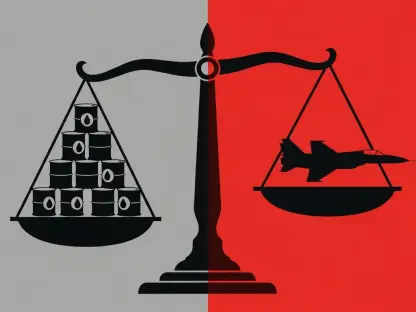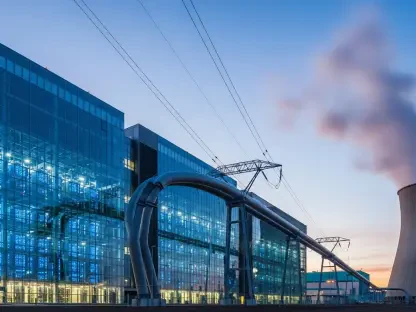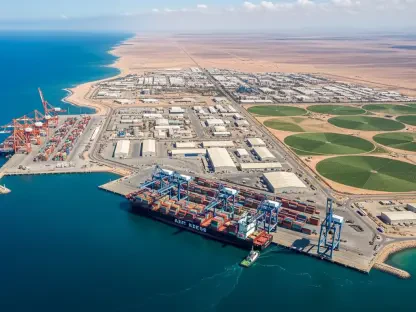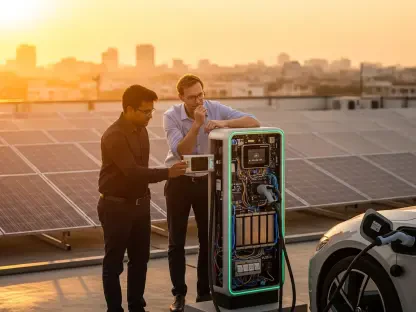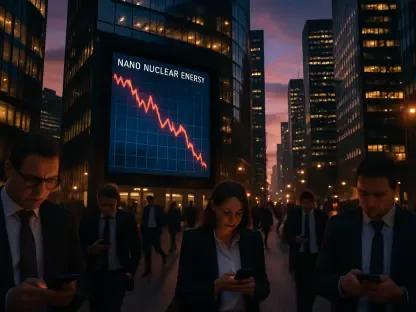The energy sector is undergoing a transformative shift driven by the increasing need for sustainability, efficiency, and transaction transparency. Blockchain technology has emerged as a powerful tool in this transformation, offering decentralized and reliable solutions for managing energy systems. Not only is it set to significantly expand the sector’s capabilities, but the blockchain in energy market is also witnessing a growth trajectory, predicting a valuation of USD 18.8 billion by 2032, propelled by a robust compound annual growth rate of 38.9%. This development underscores blockchain’s potential to redefine energy markets globally, highlighting its critical role in energy trading, grid management, and integrating renewable sources.
Key Themes and Points
Projected Growth and Market Expansion
The blockchain in energy market is expected to see significant growth, expanding from USD 0.9 billion in 2024 to an impressive USD 18.8 billion by 2032. This remarkable growth is primarily fueled by an increasing demand for transparent and secure energy transactions and greater efficiency in grid management through decentralized models. As energy markets move away from centralized frameworks, blockchain facilitates peer-to-peer energy trading and empowers consumers and producers to interact in a decentralized network. The market’s dynamic evolution makes blockchain a crucial element in modernizing energy infrastructure, ensuring system stability and enhancing transaction transparency.
By promoting real-time data tracking and accountability, blockchain technology helps energy markets overcome existing challenges related to data accuracy and fraud prevention. Its intrinsic characteristics, such as immutability, provide a resilient system for logging transactions, fulfilling the operational and regulatory needs of energy stakeholders. As countries push toward achieving net-zero emissions and integrating renewable energy sources, blockchain offers a trusted and secure method for verifying origin and energy use, essential for embracing the future energy transition.
Decentralized Systems and Emerging Trends
Decentralized energy systems are fostering a shift from traditional, centralized grids to more versatile and responsive models, largely enabled by blockchain. This transformation supports the rise of peer-to-peer energy trading, allowing individuals and small production units to trade excess energy directly with other users. This model bypasses traditional utilities and fosters the development of localized energy markets, enhancing grid flexibility and accommodating renewable energy sources. Blockchain’s role in these systems is pivotal as it facilitates seamless, transparent, and trusted exchanges through smart contracts, eliminating the need for intermediaries in transactions.
Additionally, integrating blockchain with the Internet of Things (IoT) and artificial intelligence (AI) is further driving innovations in grid automation and efficiency. IoT devices generate vast amounts of data, which blockchain securely logs and AI analyzes to make precise adjustments in energy distribution. Through this synergy, energy systems become more responsive, enhancing resilience and reducing operational costs. Using smart contracts in grid management optimizes energy flow, enabling demand response strategies where energy consumption patterns adapt dynamically to market signals, ultimately strengthening the stability and sustainability of energy networks.
Market Drivers and Trends
Government Support and Technological Advancements
Governments worldwide are increasingly supporting blockchain applications in the energy sector, recognizing its ability to enhance transparency, security, and efficiency. Regulatory initiatives, such as those seen in the EU and Asia-Pacific, are designed to encourage blockchain trials and pilot projects, setting the stage for broader adoption. These public-private partnerships accelerate research and development and pave the way for scaling blockchain solutions to commercial viability. Consequently, technology firms and utilities are forming alliances to explore blockchain’s potential, further driving the momentum in energy markets.
The proliferation of smart grids and the increased deployment of renewable energy resources pose challenges to existing energy infrastructures. Blockchain offers robust solutions to manage these challenges by providing an immutable and scalable framework for data management. This technology enhances system performance by ensuring secure data exchange across decentralized networks. Moreover, blockchain supports initiatives like carbon credit trading and emission tracking, offering verifiable records that aid corporations in achieving their environmental goals. As the technology matures, its role in reinforcing energy efficiency and facilitating sustainability becomes increasingly indispensable.
Empowering Local Energy Economies and Prosumers
Blockchain has emerged as an empowering tool for establishing local energy economies where prosumers—consumers who also produce energy—can actively participate in energy markets. By using blockchain-based trading platforms, they can engage in direct transactions, selling surplus energy at market-competitive rates. This autonomy leads to more efficient energy utilization and contributes to the financial viability of renewable energy systems at a community level. As more consumers start generating their power using residential solar panels or small wind turbines, these platforms help manage the supply-demand equilibrium and provide incentives for adopting clean energy technologies.
One of the uniquely transformative aspects of blockchain in energy markets includes the tokenization of energy assets. By digitizing these energy units, it becomes easier for participants to trade fractional ownership or stake in renewable energy projects, democratizing access to various investment opportunities. This creates a more inclusive market structure where participation is broadened beyond large-scale energy producers. Tokenization facilitates transparent fundraising initiatives, making it easier for innovators and entrepreneurs to secure funds for green initiatives while providing investors with verifiable project performance insights through real-time tracking features.
Challenges and Constraints
Technical and Regulatory Obstacles
Despite blockchain’s promising potential in revolutionizing energy markets, several challenges need to be addressed to ensure successful implementation. Foremost among these is scalability; blockchain must adeptly handle vast transaction volumes to support real-time system operations without compromising speed or accuracy. The compatibility of blockchain systems with existing legacy infrastructures also poses significant obstacles, necessitating platform enhancements to achieve cross-platform interoperability. Moreover, some blockchain networks, notably those relying on energy-intensive proof-of-work consensus mechanisms, raise sustainability concerns by consuming massive amounts of energy themselves.
Another notable barrier is regulatory uncertainty. Currently, there are ambiguities in the classification of digital assets, taxation policies, and the legal standing of smart contracts. Establishing clear regulations and ensuring compliance with existing legal frameworks is crucial for providing a stable environment conducive to growth. Moreover, the high initial investment costs coupled with a shortage of skilled professionals specializing in blockchain development add layers of complexity, particularly for smaller utilities and startups working with limited resources. The path forward requires targeted education and training programs to bridge this skills gap and drive business adoption of blockchain technologies.
Addressing Security and Cost Concerns
Security remains a critical concern in deploying blockchain technologies, especially regarding vulnerabilities in smart contracts that could be exploited if improperly developed or audited. Robust security protocols and thorough testing are essential to mitigating risks and ensuring the integrity of blockchain applications. The implementation of best practices in software development, alongside continuous monitoring and upgrading of systems, is necessary to prevent unauthorized access and ensure the safety of transactions.
The financial aspect of adopting blockchain also presents a challenge, as initial setup costs can be prohibitive for some entities. This financial burden particularly affects small and medium-sized enterprises within the energy sector that may not have the capital or expertise needed to develop and maintain blockchain systems. However, innovative financial models and Blockchain-as-a-Service (BaaS) offerings provide alternatives to traditional ownership, allowing firms to outsource their blockchain needs to specialized providers. These services can help reduce entry barriers and expedite the deployment of blockchain solutions across the energy landscape.
Opportunities for Future Growth
Innovations in Microgrids and Electric Vehicles
Integrating blockchain technology in microgrid systems presents remarkable opportunities for optimizing local energy sharing and billing processes. Microgrids, often community-led initiatives, benefit from blockchain’s ability to securely and transparently manage energy resources. By distributing power generation and consumption within a localized grid, these systems foster energy independence and support using renewables. Blockchain ensures that energy transactions within microgrids are precisely recorded, reducing billing disputes and promoting equitable energy distribution among participants.
Furthermore, blockchain’s potential in the burgeoning electric vehicle (EV) sector is substantial. With the rise of EV adoption, energy markets must adapt to accommodate the increased demand for charging infrastructure. Blockchain can streamline EV charging processes by securely tracking transactions, verifying the use of renewable energy for charging, and facilitating seamless vehicle-to-grid payments. This approach not only enhances the efficiency of charging networks but also supports grid resilience by enabling storage and redistribution of electricity from EVs back to the grid during peak demand periods.
Decentralized Autonomous Utilities and Green Financing
Looking ahead, the concept of decentralized autonomous utilities (DAUs) is gaining traction, offering new possibilities for blockchain-based energy networks governed by smart contracts. DAUs operate with reduced operational costs and provide communities with equitable access to energy resources. These autonomous systems can dynamically manage energy supply and demand, optimizing resource allocation and streamlining operations. The reduced reliance on central authorities enables communities to maintain control over their energy infrastructure, further driving the decentralization of energy markets.
Blockchain platforms also offer innovative solutions for green financing, streamlining investments in eco-friendly projects. Through tokenization, stakeholders can pool resources to fund renewable energy projects, while smart contracts facilitate transparent tracking of funds and project milestones. This boosts investor confidence and accelerates capital flow into projects aimed at decarbonizing the energy sector. Blockchain-enabled crowdfunding platforms democratize access to green investments, empowering smaller investors and bolstering the transition to sustainable energy systems on a global scale.
Shaping the Future Energy Landscape
The energy sector is currently experiencing a significant transformation as it strives for enhanced sustainability, efficiency, and transparency in transactions. This shift is significantly aided by the advent of blockchain technology, which stands out as a crucial enabler in this revolution. Blockchain offers decentralized, trustworthy solutions that are proving invaluable in effectively managing energy systems. Not only does it promise to greatly extend the sector’s capabilities, but the blockchain in the energy market itself is on a promising upward path. Predictions indicate it could reach a valuation of USD 18.8 billion by 2032, bolstered by a compelling compound annual growth rate of 38.9%.
This projected growth highlights blockchain’s considerable potential to reshape energy markets globally. Its vital role is already becoming evident in areas such as energy trading, where it offers secure and transparent transaction processes. Additionally, blockchain is playing a transformative part in grid management, ensuring more efficient operations and reliability. Furthermore, it aids in the seamless integration of renewable energy sources, which is critical as the world continues to transition towards sustainable power solutions. By offering improved record-keeping, smarter trading systems, and more resilient grids, blockchain technology is redefining the future of energy systems.


